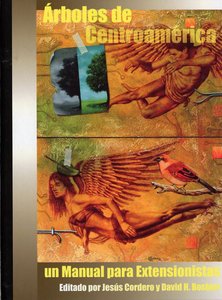Establishment and management of trees in agroforestry systems
Beer, J., Ibrahim, M., Barrance, A., and Leakey, R. (2004) Establishment and management of trees in agroforestry systems. In: Cordero, Jesus, and Boshier, David H., (eds.) Trees of Central America: a manual for extentionists. Oxford Forestry Institute, Oxford, UK, pp. 198-242.
![[img]](https://researchonline.jcu.edu.au/26569/1.hassmallThumbnailVersion/26569_Cover.jpg)
|
Image (JPEG) (Book Cover)
- Cover Image
Download (248kB) |
|
|
PDF (Published Version- English)
- Published Version
Download (5MB) |
||
|
PDF (Published Version- Espanol)
- Published Version
Download (5MB) |
Abstract
In Central America almost all of the traditional agricultural systems, including livestock management, include isolated trees in the crop fields, or incorporate alternating zones of trees, crops and/or pasture. These are agroforestry systems. Even with the modernization of agriculture in the region, agricultural landscapes still contain a large number of trees. These trees can provide a variety of products such as timber, firewood, animal fodder, fruit, and medicinal products; as well as providing services such as shade for crops and animals, and windbreaks. Trees increase the potential for biological diversity in agroecosystems by providing habitat in the branches, roots, and leaf litter; food in the form of leaves, sap, and nectar; and may provide essential protection during critical stages of organisms' life cycles. Trees improve soil fertility by adding leaves and fine roots to the organic material in the soil, and sometimes by fixing nitrogen. Trees contribute to ecosystem function, and are valuable in the formation of balanced ecosystems that have the capacity to sustain production and provide farmers with a reliable subsistence system.
| Item ID: | 26569 |
|---|---|
| Item Type: | Book Chapter (Teaching Material) |
| ISBN: | 978-0-85074-161-2 |
| Keywords: | agroforestry, central america, selection criteria, domestication |
| Additional Information: | Book Title (Espanol): Arboles de Centroamerica: un Manual para Extensionistas Chapter Title (Espanol): Establecimiento y manejo de árboles en sistemas agroforestales Abstract (Espanol): En América Central, casi todos los sistemas agrícolas tradicionales, los cuales incluyen los sistemas ganaderos, tienen árboles intercalados con cultivos o manejados en una forma zonal alternando árboles y cultivos y/o pastos; es decir, son sistemas agroforestales. Aún con la modernización de la agricultura de la región, los paisajes agrícolas todavía contienen un alto número de árboles. Estos árboles cumplen con muchos propósitos como producción (madera, leña, forraje, frutas, medicinas, etc.) además de servicios (sombra para cultivos y/o animales, protección como en el caso de cortinas rompevientos, etc.). Además, los árboles aumentan la diversidad biológica del agroecosistema creando en sus ramas, en sus raíces y en la hojarasca, hogares para otros organismos. También proporcionan a muchos organismos comida a través de las hojas, la savia, el néctar y pueden darles protección esencial durante etapas críticas de sus ciclos de vida. Contribuyen a mejorar la fertilidad del suelo, aumentando la materia orgánica del mismo a través de la caída de hojarasca y la renovación de raíces finas. Algunos árboles también pueden ser fijadores de nitrógeno. Los árboles refuerzan la función del ecosistema y contribuyen a formar ecosistemas equilibrados que sostengan la producción y fortalezcan el sustento de los agricultores. |
| Date Deposited: | 17 Apr 2013 06:29 |
| FoR Codes: | 07 AGRICULTURAL AND VETERINARY SCIENCES > 0705 Forestry Sciences > 070501 Agroforestry @ 100% |
| SEO Codes: | 82 PLANT PRODUCTION AND PLANT PRIMARY PRODUCTS > 8201 Forestry > 820103 Integration of Farm and Forestry @ 100% |
| Downloads: |
Total: 6860 Last 12 Months: 58 |
| More Statistics |



